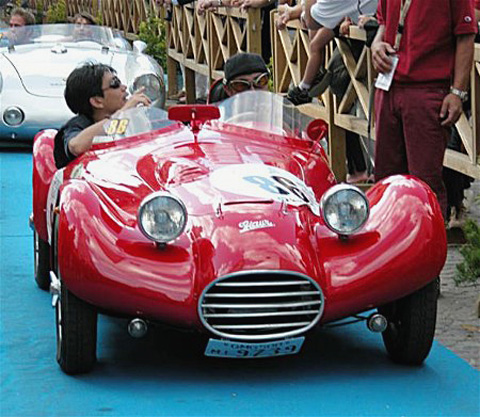
Why are we so fascinated by Ecterinis?
Because we don’t know much about them. Because they are so rare. Because they are so tiny. Because they are so cute. Because they raced the great races. Because they were built by artisans. Because they are like miniature Ferraris. Because they sound great. Because they represent an era we will never see again. Because they are Italian.
So, exactly what is an “Etceterini” anyway?
Broadly speaking, Etceterinis are tiny, jewel-like race cars from Italy with names that usually ended in a vowel. But today, with vastly increasing prices, limited availability, and international recognition, it might be time to definitively define the word, the class, the car. So we asked two who should know, Italian car historian John de Boer, and Stu Schaller, who reportedly coined the term back in the 1970s.
“A word used to characterize a rather homogenous grouping of automobiles “made in Italy” (wholly or partially) that are so varied and of such limited production that they are not easily described by lumping them together with any other grouping of true “production” cars, even though they may incorporate some of the same parts in their construction. In the strictest sense the word might seem to exclude marques such as Alfa Romeo, Ferrari, Fiat, Lancia, Maserati and other manufacturers on a grand scale, but each of these firms has produced cars that fulfill the meaning, particularly in their formative years, and these should not always be excluded,” wrote de Boer.
Schaller’s response was more concise but less defined. “I have always used Etceterini as nothing more a generic term to group together all the obscure Italian makers of small displacement sports and racing cars.”
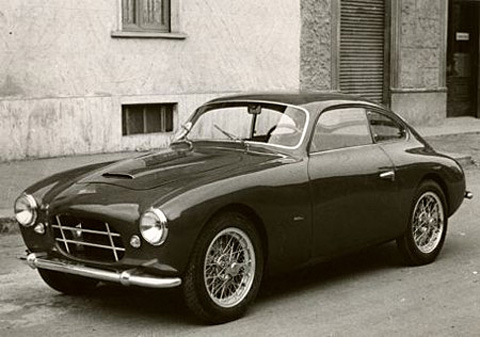
Grand Touring cars like this ultra rare and pretty Giaur may not be race cars but qualify as Ecterinis.
Both tries beg questions, but that’s half the fun. What about a Moretti GT coupe or sedan? What about Abarths, any, all or just some? What about OSCAs, any all, or some? What about Formula 500, 750s and F Jrs? It’s a bit open here.
There is another way to define an Ecteterini. If whatever etcetera you have or want or are discussing doesn’t appear in La “Sport” e i artigiani, it is probably not an Etceterini.
“The Sport and its craftsman” (or artisans) is a 356 page homage to the cars we would refer to as Etceterinis. Notably, the authors, Andrea Curami and Piero Vergnano never mention the word. Says de Boer, “Etceterini is automatically plural. A single Siata (or Nardi or Stanga) cannot be “an etceterini” but collectively they are “etceterini”. And I hasten to point out that, in Italian, they are “ecceterini”, a word which I actually prefer, but which may raise even more consternation than that which has been expressed by some Italians who rightly pointed out early on that “etceterini” was not really a word. It seems to have become a word.” So those of you who wish to speak of these cars in the singular or plural have been warned. But since the term Ecteterini has been in common use for about 30 years, we will use it as a proper noun, capitalized, and not worry about singular or plural usage.
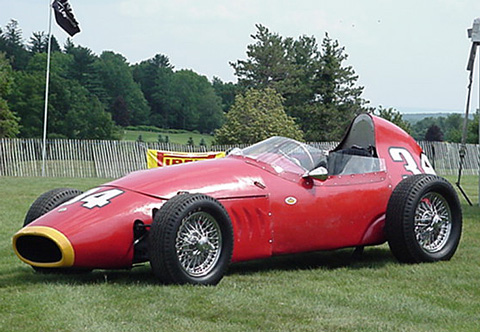
They could be coupes, sports racers, or formula cars. Here is the Stanguellini Formula Junior, Ecteterinis all.
Curami and Vergnano really got into the rare, obscure, individual, and handmade (by artisans of course) tiny race cars which contested the 750, 1100 and under 1500 cc classes of the Italian National Championship races, held between 1937 and 1965 (these races constitute the “Sport” in the title of the book). Artigiani means craftsman or artisan, an occupation that, note the authors, often produces true masterpieces. And certainly some were exactly that. Curami and Vergnano did not address Ferrari, Maserati, Alfa Romeo, high production Abarths, or even Cisitalias, as there is ample literature to support those marques. The main body of the work is devoted to eighty four different makes of Italian race cars we can generally assume you haven’t heard of. All but eight of the names end in a vowel—names like Ala d’Oro, Aguzzoli, Bottega, Faranda, Mariani, Paganelli, well, etcetera.
History
In general, Etceterinis were raced in only two places; in Italy and post war, in the U.S. In Italy to compete in the Italian Championship for sportscars, and in the U.S. to find success in the SCCA’s H modified classes, for many years limited to 750 cc. G modified classes accommodated 1100cc sports racers and there too, one would find a variety of Bandinis, Abarths, and Nardis. (BTW, a great place to see all results and reports of those early SCCA races is on Cliff Reuter’s site.)
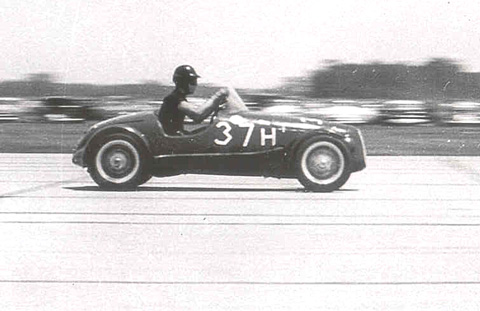
A Siata at speed down the runway at an SCCA airport event at Atterbury, driven by J.G. Whitlock. The “H” indicates the car was entered in the H modified class in this race.
The U.S., in addition to having a booming growth in sports car racing, had the Crosley engine, a tiny, single overhead cam engine well suited to the 750 cc class. Many Giaurs, Bandinis, and Siatas came into the U.S. sans engine and were immediately equipped with a full race Crosley. Lastly, two or three importers were making a good deal of money by bringing the cars into the country—among them Tony Pompeo (need ref), John Edgar and Ernie McAffee (ref Siata br).
The came, they conquered, and after the mid fifties, languished in garages across America (see Reuter Bandini story). Until one day in 1984, as something called vintage racing was taking off, Road & Track, already noting the rising prices of old race cars, told its readership, “Buy that Bandini Now”.
Are they fast?
Most Etcets are 750 to 1100cc, very light in weight but high revving and low torque race cars. A great deal of fun however. Cliff Reuter has driven more than his share and finds that “..a SOHC with usually 50bhp and around 800 pounds, they couldn’t be called slow. Perhaps the fastest 750cc is the 1955 #358 Bandini Series 2 DOHC Siluro which has 71bhp weighing only 750 pounds, which makes for a head snapping experinece and 115 miles per hour. And sitting 3 inches off the ground makes for great handling and a heady impression of speed.”
What does one do with one?
That, my friend is a good question. Vintage racing, yes, of course. But since the small displacement classes are filled with later, bigger and much faster British racers you’ll be back packing.
We’ve known some who will hang them on the wall of their den.
On nice summer days, a few will roll there cars out onto the driveway and sip a glass of wine while appreciating the voluptuous series of French curves found on a Giaur, Bandini, or Stanguellini.
Others save them for shows, as classes for the cars are now coming into play, such as the Etceterini class this year at Amelia Island Concours. You can take them to the most prestigious events in the world like the Mille Miglia, Pebble Beach, Villa D’este. They get the same respect as the best Ferraris, Maseratis with a fraction of the cost.
Are they art?
Beauty is in the eye of the beholder. There are a few that are drop dead beautiful Italian miniatures; we submit for your approval the Bandini Saponetta, Siluro, Moretti 750 Coupe, the Giaur.
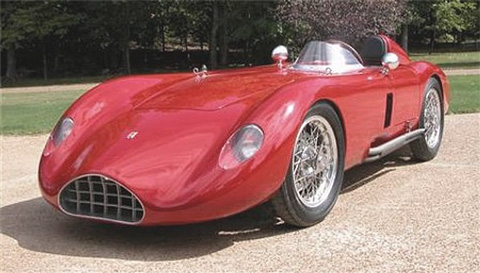
The Bandini “Sapponetta”–little bar of soap–is classic Italian sports racing art.
But are they art? If you include a Ferrari 250TR in your definition of what is art, then certain Etceterinis definitely qualify as works of art. The major difference is in size, and in general is it harder to create a beautiful small car than a beautiful mid size car.
Where can they be found?
On ebay of course. They can be found in Italy, California, and we all know there is a huge hoard in Northern California and another in the Midwest. There was once quite a few in the Northeast. Many have gone to Japan and back to Europe as the dollar falls.
Readers with questions feel free to ask away, either comment below or go to the VeloceToday Facebook page.
I was really pleased to read this article. As the owner of one of the very few remaining Giaur Champions, I have always to explain what is this car, the history of it etc. The car is now in Greece and it will be shown to the 2010 Villa D’Este Concorso D’Eleganza. Pictures to follow…
I’d like to know if John de Boer considers the Arnolt MG an Etceterini?
The cars you called etceterini use to race also in Argentina where the largest population is italian and I have seen racing in small clases FIAT,Cisitalia ,Abarth, Nardini,Gordini,Renault,Isard,NSU etc etc
Most of the races took place in the Circuit of the City of Buenos Aires,Circuit of the Park in Parana and Mendoza.
What a great article.So informative and exploratory i.e. revealing cars and definitions and history. Thanks
The idea that such a varied group of cars can be classified is new to me.
I’m certain that the members of the tidewater Alfa club are aware. I’ll inquire at next month’s meeting.
You should prepare a talk and be o0ur quest speaker some month. I’ll raise this idea also.
Great info !
Where do I buy the book?
Great stuff again Pete! Of course, it was Moretti I was seeking when I wrote about Karl L. More please. John has to have the greatest depth of knowledge on so many of these cars and needs to be threatened physically to produce the book that puts pictures and words to the engine and chassis numbers plus driving impressions. If someone does not get the job done soon, we could all be dead. Of course, when considering the desirability of these things with a mind to a purchase, a great deal is taken on faith – especially if one is sufficiently unwise to buy from overseas without first having a drive. Having said that, I have never driven a bad Abarth. As it is now several years since La Sport was printed, have they done an English version yet, or has anyone translated it?
Please, may we have more and more …
Adrian
Question of Alex Vazeos:
Who built the bodywork of this beautiful little “Giaur Champion”? Is that really what it’s called? It’s captioned as a Giaur 750 Berlina..
To Terry Sanders:
No MG could ever be called an Etceterini because it’s not Italian! The word is only an invented word around “etcetera” to refer to those Italian cars that are not mainstream hence only made in tiny numbers and were never major manufacturers!
Erm – surely that should be an Etceterina? Etceterini is the plural. And I know it’s the masculine plural, and the feminine singular, but I have asked many Italians why a an Alfista (s) and another Alfista (s) become two alfisti (m), and have received the glorious reply “just because they do”. I presume the same applies to Etceterini…
Is engine displacement an absolute factor in determining “etceterini” status?
Did Intermeccanica make it into the book with their little ‘IMP’? What about the larger and more beautiful Intermeccanica Italia?
On the MG Arnolt, remember that the terms were “built in whole or in part in Italy”.
The Bertone bodywork on the MG Arnolt is so heartbreakingly pretty Italian I personally will make my own personal exception…yes, it absolutely qualifies as “etceterini”. I can’t imagine anyone except the Italians making the car around that great MG TD grill look so regal!
de Boer’s original, long out-of-print, and much-sought after book, commonly referred to as “The Etceterini Register” includes the Arnolt MGs in its lists, so to answer your question, yes, they are…
To Norman:
The bodywork of the Giaur was designed and built in house by Berardo Taraschi. It was believed that Motto designed it but this is wrong. Motto only did the Twincam coupe which is lost. The name of the car is Giaur Champion 750. I also bought Cliff Reuter’s Bandini Siluro and a twin cam Moretti 1200 Grand Sport. I also have an Abarth Record Monza, a Double Bubble and an Abarth Simca 1300 Corsa. I guess i do qualify as an etceterini addict, right?
Oh I would say you qualify more than just an etceterini addict. I would say you are a veritable etceterini nutter!!LOL
Hello all,
I cannot begin to pretend that I should tell you all how to use the word “etceterini”.
I recall being asked by Pete Vack (last year or the year before?) what my own definition of “etceterini” is. And I recall giving a detailed answer that I hoped would acknowledge the vagueness intended by my use of the word. I cannot speak to Stu Schaller’s (or onyone else’s) interpretation of the word that I recall selecting (I think during 1980) over a dozen word possiblities that I also created at about the same time that I formalized my studies without knowing where they would lead. I have not read the story that appears here as I am not a subscriber. In short, I do not know if I was quoted correctly or completely. But, I can read the comments and it seems that a number of people have missed the point … by my own interpretation anyway.
Regarding the seeming desire expressed here to either be included (or perhaps excluded?) from the broad brush-strokes covered by my interpretation of the “etceterini” moniker, I can only say that it was intended to be a generic term and never a specific label. As soon as you call your Siata or Arnolt an “etceterini”, you’ve missed the point. It would be more accurate to say that your Siata is part of a broad grouping of cars that are embraced by the term. The same goes for the Arnolt-MG. It is perhaps best to equate it with the word “humanity”. I consider the concept to be a bit like racial groupings for people. As soon as you begin to differentiate too specifically between one and another, or the degree of “etceterini-ness”, there is the risk of becoming something akin to being a racist. I never had any notion that people would take this so seriously! Myself included.
“Etceterini” was intended to be a study aid. The Italian Car Registry publication of 1994 was intended to be a study aid and never a “bible” or any kind of ultimate reference to “truth”. That said, there was a lot of truth that seems to have been ignored by the mainstream media including far too many folks who “publish” on the internet. The 1994 publication was presented as a departure point for additional study as well as an appeal for additional information. It was an implied appeal for updates. It was a general request for corrections to what seemed to be information that seemed mostly reliable at the time but which was not necessarily proven to be accurate in each detail. Although there are surprisingly few out-and-out errors, particularly considering the amount of material covered, there are many data points that are still not confirmed and many that are simply no longer representative of what is known today. There are a few typos. The small number of errors can mostly be attributed to the heavy editing that I did while producing the final listings. With a couple of exceptions, the format allowed roughly 132 characters to describe each car. There was a huge amount of data that was not included. After more than fifteen years collecting data there is now an additional huge amount of data that gives tremendous additional perspective but much of this will also be subject to heavy editing in a similar listing that will be done in the future. Even without threats of physical abuse.
I have shared many listings with many who have shared information in the intervening years. I’ve attempted to share some information with VT in the past only to have it be mocked by an ignorant individual on the staff. I have shared some listings through the AlfaBB (www.AlfaBB.com) and elsewhere. Comparing the listings that have been shared in the last few years with those from 1994 will give some idea as to how much has been learned.
Why have I not yet done another publication? There have been many distractions. As I began to prepare an update at one point, I became aware of a major theft of my listings when they were republished on the internet by classicscars which pretended the research was their own. I began to become distracted by devising strategies to deal with a future simiar theft. I have also been awaiting for those with greater financial power to remove the offending parties from the collector car scene. I have also been apalled by the frequent misuse of the information that was presented. Surprised by others who have “stolen” information and re-presented it as their own without even a simple acknowledgement. Astonished that some others have begun their own studies using mine as a starting point but who have never contacted me to see if we might work together. Astounded that there are so many basic inaccuracies that continue to appear in print and on the internet, some of them promoted by persons who present themselves “experts”.
I was not aware that the word “etceterini” had created a true mystery of its own. Only that others have taken it and made it their own. As has probably happened many times in the history of language. The word is no longer mine. If it ever truly was.
John de Boer
The Italian Car Registry